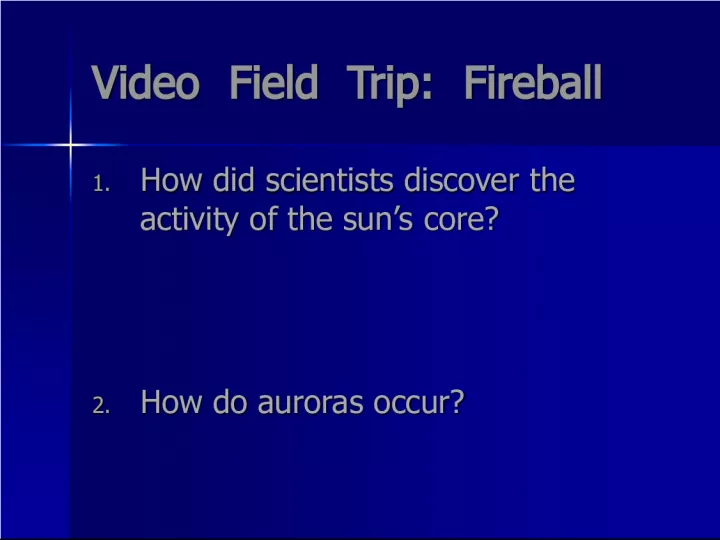"Sun's Core Activity: Unveiling the Mystery"


Join us in this Fireball Video Field Trip to unravel the mystery behind the activity of the sun's core through the eyes of scientists. Discover how they did it and their findings.
- Uploaded on | 0 Views
-
 nevaeh
nevaeh
About "Sun's Core Activity: Unveiling the Mystery"
PowerPoint presentation about '"Sun's Core Activity: Unveiling the Mystery"'. This presentation describes the topic on Join us in this Fireball Video Field Trip to unravel the mystery behind the activity of the sun's core through the eyes of scientists. Discover how they did it and their findings.. The key topics included in this slideshow are . Download this presentation absolutely free.
Presentation Transcript
1. Video Field Trip: Fireball Video Field Trip: Fireball 1. How did scientists discover the activity of the sun’s core? 1. How did scientists discover the activity of the sun’s core? 2. How do auroras occur? 2. How do auroras occur?
2. The Study of Light The Study of Light Chapter 24, Section 1 Chapter 24, Section 1
3. Electromagnetic Radiation Electromagnetic Radiation Electromagnetic radiation includes gamma rays, X- rays, ultraviolet light, visible light, infrared radiation, microwaves, and radio waves Electromagnetic Spectrum – the arrangement of electromagnetic radiation according to wavelength All energy, regardless of wavelength, travels through the vacuum of space at the speed of light (300,000 km/s) Light has a dual nature, it is both a wave and a particle Each color of light has a specific wavelength (with red having the longest and violet having the shortest) Photon – a small packet of light energy Shorter wavelengths have more energetic photons
4. Electromagnetic Spectrum Electromagnetic Spectrum
5. Spectrum of Light Spectrum of Light
7. Concept Development Concept Development What are photons? What are photons?
8. Spectroscopy Spectroscopy Spectroscopy – the study of the properties of light that depend on wavelength Spectroscopy – the study of the properties of light that depend on wavelength Continuous Spectrum – an uninterrupted band of light emitted by an incandescent solid, liquid, or gas under pressure Continuous Spectrum – an uninterrupted band of light emitted by an incandescent solid, liquid, or gas under pressure Absorption Spectrum – a continuous spectrum produced when white light is passed through a cool gas under low pressure; the gas absorbs selected wavelengths of light, and the spectrum looks like it has dark lines superimposed Absorption Spectrum – a continuous spectrum produced when white light is passed through a cool gas under low pressure; the gas absorbs selected wavelengths of light, and the spectrum looks like it has dark lines superimposed Emission Spectrum – a series of bright lines of particular wavelengths produced by a hot gas under low pressure Emission Spectrum – a series of bright lines of particular wavelengths produced by a hot gas under low pressure When the spectrum of a star is studied, the spectral lines act as “fingerprints” When the spectrum of a star is studied, the spectral lines act as “fingerprints” These lines identify the elements present and thus the star’s chemical composition These lines identify the elements present and thus the star’s chemical composition
9. Three Types of Spectra Three Types of Spectra
10. Solar Spectrum Solar Spectrum
11. Concept Check Concept Check Compare and contrast the three different types of spectra. Compare and contrast the three different types of spectra.
12. The Doppler Effect The Doppler Effect Doppler Effect – the apparent change in frequency of electromagnetic or sound waves caused by the relative motions of the source and the observer Doppler Effect – the apparent change in frequency of electromagnetic or sound waves caused by the relative motions of the source and the observer The light from a source that is moving away from an observer appears redder than it actually is because its waves are lengthened (red-shift) The light from a source that is moving away from an observer appears redder than it actually is because its waves are lengthened (red-shift) This effect is only visible to the human eye when objects are moving close to the speed of light This effect is only visible to the human eye when objects are moving close to the speed of light In astronomy, the Doppler effect is used to determine whether a star or other body in space is moving away from or toward Earth In astronomy, the Doppler effect is used to determine whether a star or other body in space is moving away from or toward Earth Large Doppler shifts indicate higher speeds; smaller Doppler shifts indicate slower speeds Large Doppler shifts indicate higher speeds; smaller Doppler shifts indicate slower speeds
13. The Doppler Effect The Doppler Effect
14. Measurement of Doppler Shifts Measurement of Doppler Shifts
15. Concept Check Concept Check How can scientists determine whether a star is moving toward or away from Earth? How can scientists determine whether a star is moving toward or away from Earth?
16. Assignment Assignment Read Chapter 24, Section 1 (pg. 674-677) Read Chapter 24, Section 1 (pg. 674-677) Do Chapter 24 Assessment #1-34 (pg. 695- 696) Do Chapter 24 Assessment #1-34 (pg. 695- 696)